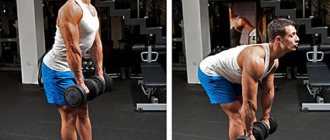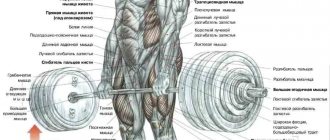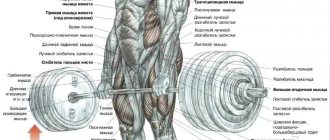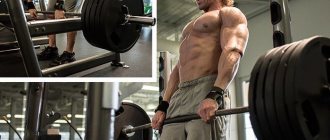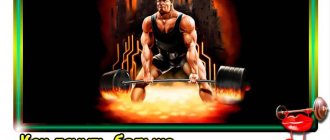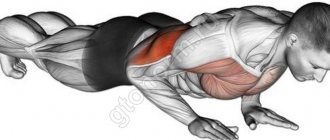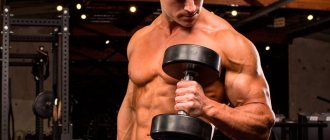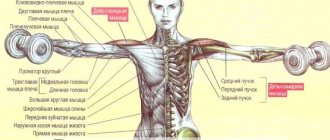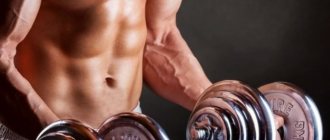The dumbbell deadlift is a great exercise for beginners, athletes recovering from injury, or those who, for example, are cutting and working with light weights. You can also include this exercise in your workout instead of the classic barbell deadlift for variety.
- What muscles work when performing deadlifts with dumbbells?
- Benefits of Dumbbell Deadlifts
- Types of deadlifts and technique, how to do deadlifts with dumbbells correctly
- Classic deadlift with dumbbells for men and girls
- Romanian and deadlift with dumbbells
- Single leg deadlift
- Sumo deadlift with dumbbells
- Recommendations for performing the exercise
Is there any benefit to deadlifting with dumbbells?
If you are a man and can easily lift 100 kg from the floor, then you don’t need dumbbells. On the contrary, your strength will decrease if you lift lighter weights. But girls are a different matter. When a girl comes to the gym, it’s hard for her to do deadlifts with a 20-kilogram bar. Need less weight.
Sometimes after an injury it is important to start bending, no matter with straight legs or bent legs, with very light weights. Two small dumbbells are a great option. The lower back muscles work better than when bending over without weight. The load is coming, there is a sense. We conclude: deadlifts with dumbbells are an effective exercise for some.
It will suit you if:
- You are a beginner athlete and the weight of the barbell is still too heavy for you.
- You are recovering from an injury and high loads are contraindicated.
- You train at home, and you simply don’t have a barbell. But there are more versatile dumbbells.
Warm-up
Compared to other sets of exercises, ST does not require preliminary warm-up. It is enough just to lift the weight several times to evaluate it and warm up the muscles. You can also use the following exercises as a warm-up:
- Stretching. Warming up of the muscles of the arms, legs, lower back, and joints is required first. Exercises should be calm, measured, you should not load the body, but return it to tone. After stretching, it will be easier to perform any activity with weights.
- Standard warm-up. A classic set of exercises that involves working all muscle groups. Starts with the neck and ends with the feet. It combines dynamic and static movements.
- Special warm-up. Used by professional athletes who perform heavy levels of ST. The level of load and duration of the warm-up are selected by the trainer, since further combination with the apparatus requires a lot of strength and energy.
Advice! You should not devote a lot of time and effort to preparation, since the main work should happen exclusively while working with the load.
Muscle work in exercise
Regardless of what kind of equipment we take: dumbbells, kettlebell, barbell, deadlift remains the same exercise for the same muscle groups.
Depending on what type of traction we have chosen, the emphasis of the load may shift. Muscle work looks like this:
- Back muscles. For the most part, the load falls on the back extensors, especially on their lumbar part. The lats and trapezius are slightly involved.
- Muscles of the legs and buttocks. These are the quadriceps (they work during the classic deadlift, they are switched off in the deadlift on straight legs, in the Romanian they are minimally involved), the hamstrings (they work everywhere, but most of all in the deadlift), the gluteus maximus muscles (here the leader in load is the Romanian).
- Forearm muscles. They are loaded due to the fact that you are holding the weight with your hands.
Many more muscles are slightly involved. They help the main working groups and stabilize the core.
In other words, in an exercise with dumbbells everything is exactly the same as with a barbell. The projectile is different, but the movement technique is the same.
Deadlift standards for all categories awpcwpc
There are several classifications with different standards depending on the equipment according to the international powerlifting organization (ipf) awpc/wpc. The standards depend on the sports category:
- In single layer WPC gear
Single layer equipment
- In single layer AWPC gear
Single layer equipment
- In multi-layer WPC gear
Multilayer equipment
- In multi-layer AWPC gear
Multilayer equipment
- Without WPC equipment
Without equipment
- Without AWPC equipment
Without equipment
Explanation of symbols:
- MSMK - master of sports of international class
- MS - master of sports
- Candidate for master of sports (candidate for master of sports)
- I - first rank
- II - second category
- III - third category
- I (yu) - first youth category
- II(yu) - second youth category
- WPC - World Powerlifting Congress, international powerlifting federation (WPC)
- AWPC - Amateur World Powerlifting Congress, WPC amateur league, doping control is in place during competitions (AWPC)
- IPF - International Powerlifting Federation IPF
Types of deadlifts with dumbbells
As mentioned above, you can do all the same rowing options with dumbbells as with a barbell. However, there are some nuances. For example, the sumo deadlift involves working with significant weights. This is a powerlifting exercise. The classic bent-leg deadlift with dumbbells is more suitable for beginner men or girls. Of course, dumbbells come in 20 kg weights, but with this weight the barbell becomes much more convenient.
Therefore, trying to perform heavy deadlifts with dumbbells is not advisable. But the dead and Romanian traction can be fully recommended.
Let's take a closer look at the technique.
Deadlift with dumbbells
Let's look in detail at how deadlifts with dumbbells are performed. You can also use this exercise at home. Buying a pair of dumbbells is not difficult, and very useful. These are universal weighting agents. You can do so many things with them, so many muscles can be strengthened!
So let's warm up well. To perform the dumbbell deadlift exercise, you will need a good stretch in the lower back. After warming up, you need to stretch your muscles a little to prepare them for work.
- We stand with our legs slightly narrower than our shoulders and our gaze straight. The legs are straightened at the knees and at the same time slightly relaxed. This way your knees won't lock. They will be held in place by the strength of the muscles, not by the knee joint brace.
- The lower back should be slightly arched so that the pelvis goes back (natural deflection), the shoulders are straightened, the shoulder blades are slightly brought together (to a natural position with correct posture).
- We bring our hands in front of us, turning them with our palms towards our feet. It is not necessary to hold the dumbbells in a straight line; you can slightly turn your hands to a position that is comfortable for you.
- We begin to lower our torso forward, trying not to bend our knees. Your center of gravity will shift forward. Compensate for this by abducting your pelvis backwards (minimum abduction of the pelvis so that your arms hang directly above the middle of your feet).
- Lower yourself until your lower back begins to round - this is the limit of your stretch for today. You will be able to do the exercise up to this level.
- Now we take weights (dumbbells) and repeat absolutely the same thing with them.
We do 10-12 repetitions in 3 approaches.
Deadlift with dumbbells - an exercise for the muscles of the lower back and the back of the thigh, buttocks. It is recommended for girls; there is no particular point in doing it for men.
You should start with light weights. The first workout should always be done with such a weight that you feel the load, but do not injure your muscles. Then gradually increase the weights until the muscles begin to receive full load. You kill two birds with one stone: prepare the tendons for the load, and accurately measure the required weight.
Note: The dumbbells, starting from just above the knee, slide along your legs. Therefore, wear pants to avoid any abrasions. This applies more to exercises with a barbell, since it is heavier than dumbbells, but it is still better to be careful.
Romanian dumbbell row
For those who are not flexible enough to do the exercise with straight legs, there is the Romanian dumbbell deadlift. Again, the exercise is intended for girls who cannot yet lift a barbell.
The weight of dumbbells should be minimal for the first time. For beginners, the muscles are not accustomed to the load. The first 3-5 reps with heavy weights may seem like nothing. After the 6th approach, severe fatigue will set in, and at least 1 more approach.
Correct technique:
- We get into the starting position with slightly bent knees. We hold dumbbells with a straight grip, palms facing our feet. You can turn them a little so that the dumbbell does not walk strictly along the front, but partially along the side surface of the thigh. Apart from the knees, the starting position is exactly the same as in the previous case.
- We bend the torso forward. The dumbbells are directed towards the feet. In this exercise, the pelvis goes back by bending the knees. This is why you don’t need to have a good stretch, since you don’t need to stretch with straight legs.
- Lower the dumbbells to the lowest possible point so that they slide along your legs.
- We return to the original state, the pelvis moves slightly forward. At this moment, you should tighten your buttocks as much as possible and squeeze your shoulder blades together. This is the completion of straightening. We lift as we exhale, and lower as we inhale.
The knees bend at a slight angle. You should not sit down - this is not standing on bent legs.
We make all movements smoothly and thoughtfully. It is advisable to have a mirror in front of you. You will just keep your head level while observing yourself.
Deadlift with dumbbells on bent legs
An exercise that doesn't make much sense, but to be fair, it's worth mentioning. The weight is too light to load the legs and lower back at the same time. Although, if you take 20 kg dumbbells and offer them to girls or children, this will be a very good load for them.
Let's consider the classic version of traction:
- Starting position: stand, look straight, arch in the lower back, shoulder blades facing each other, shoulders straight.
- The dumbbells are in front of our toes and turned out so that we can grab them with an overhand grip. When performing the exercise, the dumbbells can be slightly rotated to a position that is comfortable for you. This is not a straight bar, but two independent projectiles.
- We begin to bend the torso forward, maintaining a bend in the lower back. We bring it to 40–45 degrees, after which we lower ourselves to take dumbbells by bending our knees. We take dumbbells and straighten up, bringing our shoulder blades together as much as possible.
- This is the starting position with dumbbells. We stand on straight legs. Now we do the same, but leave 10–15 cm to the floor, since dumbbells are not a barbell. It will take us a long time to lower them to the floor.
Since the weight is light, do 10–12 reps in 3–4 sets.
We strongly recommend starting the classics right away with a barbell. The correct technique is developed with it.
Sumo rows with dumbbells are not a practical option.
Important points
- You need to lower and raise the barbell quite slowly and smoothly;
- The downward movement must begin by moving the pelvis back;
- The bar should slide along your thighs throughout the entire movement;
- The lower back should be arched;
- After passing your knees (downward movement), you need to touch the floor bar with the weights;
- Mentally imagine that instead of lifting up, you press your feet into the floor;
- Both during lifting and while lowering the barbell, you should not put your body weight on your toes. In this case, the bar will move forward from your legs and you can simply fall forward.
- Do not do deadlifts “bounced” from the floor, i.e. don't throw her away. Even if you feel that you cannot lift the barbell, do not drop it under any circumstances. Lower it, if possible, smoothly, so that the load from your back is removed not suddenly, but gradually. Sudden removal of the load can seriously injure the muscles of the back, elbows or shoulders.
By working back and forth, you make your work much easier and pass the critical point of removing the barbell at speed. The meaning of such training disappears. Additionally, “pounding” can cause the plates on one side of the bar to slide down the bar.
This will lead to loss of control of the barbell, asymmetrical lifting of the weight and uneven load on the body, which can lead to serious spinal injuries.
- Never twist your head when you lower or raise the barbell - the barbell may tilt slightly to the side, you will be pulled to the side, and you may injure yourself.
- Don't deadlift reps to failure, don't do forced or negative reps. In such a serious exercise as the deadlift, these experiments are not appropriate.
- Do not perform deadlifts if your lower back muscles are still quite sore from your last workout or even from regular heavy physical labor. Rest for a day or two and wait until the muscle pain goes away.
- Breathing: inhale – slowly down, exhale – up.
- Avoid the main mistake of rounding your back; to do this, try to look up.
Error in all its glory
Mistakes when doing dumbbell rows
Here are some of the most common mistakes to avoid when doing dumbbell exercises:
- Dumbbells dangle from side to side. You create unnecessary stress on the muscles that provide your balance and overload your lower back.
- Fast execution. Every movement should be smooth and clear.
- Breathing disorders: we go down as we inhale, we rise as we exhale. You can remember this: we exhale for effort, and effort is made when we lift something from the floor. Usually this phrase helps you remember correct breathing during exercise.
- Round back. Even with such weights, you can round your back if you do not have good stretching, and even if you are not on straight legs.
- With the classics, we first pull with the lower back, and then straighten the body. There should be a clear algorithm - legs, then lower back. And nothing else. We lift the weight off the floor with our feet, then smoothly switch to the lower back.
- We do not bend at the end point. Such a repetition may not be counted. This is not done to pump up the latissimus muscles, but to completely straighten the back.
- Look down during the exercise. This is a serious violation of any deadlift technique.
Execution technique
When taking the starting position, the dumbbells are placed on the floor. The fall is accomplished by tensing the legs.
The projectiles are grabbed with both hands. After this, the athlete tears them off the platform by pushing with his feet. The shoulder blades are currently contracting and the back is tense. The grip is parallel and straight. Dumbbells are placed in front of the body, and not in different directions.
You need to monitor the position of your head. There is no need to lift it up.
The technique for performing this exercise is as follows:
- Lifting the projectiles is done by simultaneously straightening the joints in the pelvic area and pushing off the platform with your feet.
- The shoulder blades are brought together moderately. The fixation is less rigid than in the case of classic traction.
- When the top point is reached, the knees and pelvis bend. After this, the shells are lowered onto the platform.
You need to do deadlifts strictly according to the rules. The following nuances must be taken into account:
- The projectiles are positioned parallel to each other. Asymmetry and displacement in different directions are unacceptable.
- Dumbbells are not placed in front of you.
- Initially, medium-weight equipment is used. All actions are performed technically.
- Be sure to stretch your arms before lifting. There is no need to bend them.
The execution will be correct only if the center of gravity is located in the middle of the arch of the foot. The entire mass is not transferred to the heels or toes. Otherwise, the athlete may simply fall.
The projectiles are parallel to each other
Dumbbells are not carried in front of you
All actions are performed technically
Safety regulations
Like any other strength exercise, the deadlift (whether with dumbbells or a barbell) places stress on your body. Therefore, listen to your own feelings, and if you feel any of the symptoms listed below, the exercise should be postponed until the problem is resolved.
- Back hurts during and after exercise. You need to do hyperextensions without weights for one month to strengthen your lower back. At the same time, stretch your muscles so that your technique does not suffer from lack of stretching. Before the exercise, you can smear your back with warming ointments, you can also use painkillers. The main principle is do no harm! If the pain remains after a month of hyperextension, you should see a specialist.
- My knees hurt. It's difficult to offer anything here. Try wrapping elastic bandages around your knees. Sometimes this option helps. Sometimes not. Go to a specialist and find out if you have flat feet. If you have them, order special insoles and place them in your shoes for the gym.
- You feel dizzy when you bend over. Contact a neurologist. This shouldn’t happen (unless you are 60 years old, of course – these are age-related characteristics of the body).
To summarize the article, we can recommend the following: follow the technique, train all the muscles of your body (and not just select groups) and work for pleasure. These are the main secrets of success. Performing deadlifts with dumbbells will be a good help for you on the way to a beautiful and strong body.
Advantages
Deadlifts for girls have a positive effect on the entire body. What muscles does the deadlift work? First of all, these are the forearms, biceps, all the back muscles, muscles of the thighs, buttocks and trapezius.
This strength exercise was included in the women's fitness program for two reasons:
- Allows significant weight reduction.
- The body acquires a beautiful relief.
By performing deadlifts, a girl gets rid of excess fat deposits and cellulite, acquiring a beautiful waist and slender posture. The deadlift is an energy-intensive exercise that covers a large number of muscle groups.
